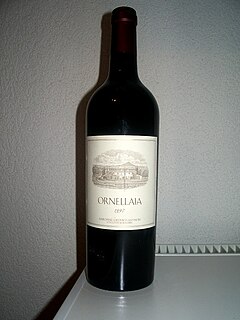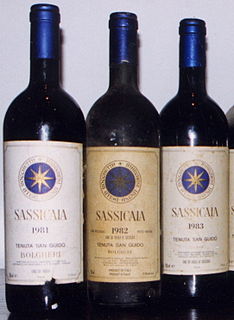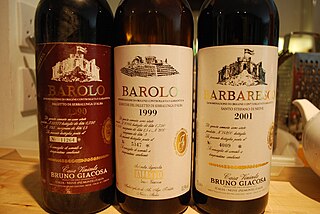
Nebbiolo (Italian), or Nebieul (Piedmontese) is an Italian red wine grape variety predominantly associated with its native Piedmont region, where it makes the Denominazione di Origine Controllata e Garantita (DOCG) wines of Barolo, Barbaresco, Roero, Gattinara and Ghemme. Nebbiolo is thought to derive its name from the Italian word nebbia which means "fog." During harvest, which generally takes place late in October, a deep, intense fog sets into the Langhe region where many Nebbiolo vineyards are located. Alternative explanations refers to the fog-like milky veil that forms over the berries as they reach maturity, or that perhaps the name is derived instead from the Italian word nobile, meaning noble. Nebbiolo produces lightly-colored red wines which can be highly tannic in youth with scents of tar and roses. As they age, the wines take on a characteristic brick-orange hue at the rim of the glass and mature to reveal other aromas and flavors such as violets, tar, wild herbs, cherries, raspberries, truffles, tobacco, and prunes. Nebbiolo wines can require years of aging to balance the tannins with other characteristics.

Brunello di Montalcino is a red DOCG Italian wine produced in the vineyards surrounding the town of Montalcino located about 80 km south of Florence in the Tuscany wine region. Brunello, a diminutive of Bruno ("brown"), is the name that was given locally to what was believed to be an individual grape variety grown in Montalcino. In 1879 the Province of Siena's Amphelographic Commission determined, after a few years of controlled experiments, that Sangiovese and Brunello were the same grape variety, and that the former should be its designated name. In Montalcino the name Brunello evolved into the designation of the wine produced with 100% Sangiovese.

Italy is the world's largest producer of wine, and is home to some of the oldest wine-producing regions. Its contribution is about 45–50 million hl per year, and represents about a quarter of global production. Italian wine is exported around the world, as popular among Italians. Italians rank fifth on the world wine consumption list by volume with 42 litres per capita consumption. Grapes are grown in every region of the country and there are more than one million vineyards under cultivation.

A decanter is a vessel that is used to hold the decantation of a liquid which may contain sediment. Decanters, which have a varied shape and design, have been traditionally made from glass or crystal. Their volume is usually equivalent to one standard bottle of wine.

Soave ( is a dry white Italian wine from the Veneto region in northeast Italy, principally around the city of Verona. Within the Soave region are both a Denominazione di Origine Controllata (DOC) zone and a Denominazione di Origine Controllata e Garantita (DOCG) designation known as Soave Superiore with both zones being further sub-divided into a general and classico designation for the wines produced in the heartland of the Soave region around the sloping vineyards of Verona.

Barbaresco is an Italian wine made with the Nebbiolo grape. Barbaresco is produced in the Piemont region in an area of the Langhe immediately to the east of Alba and specifically in the comunes of Barbaresco, Treiso and Neive plus that area of the frazione San Rocco Seno d'Elvio which was once part of the comune of Barbaresco and now belongs to the comune of Alba. It was granted Denominazione di origine controllata (DOC) status in 1966 and Denominazione di Origine Controllata e Garantita status in 1980. The wine is often compared with Barolo—another Nebbiolo based wine from the Piedmont area. Though the wines do share many similarities, there are some distinct differences between them.

Torbreck is an Australian winery in the Barossa Valley, founded by David Powell in 1994. The winery was named one of the World's Top 100 Wine Estates by Robert Parker. The winery is named after a forest in Scotland where Powell worked as a lumberjack. The wines are made in a style emulating those of the Rhone Valley and are made from various grapes including red grapes Shiraz, Grenache and Mataro as well as white grapes Viognier, Roussanne and Marsanne.

Luigi Veronelli was an Italian gastronome, wine critic and intellectual. He is remembered as one of the central activists in the appreciation and promotion of Italy's enological and gastronomic heritage. Veronelli was the first to express views that would later achieve general currency and the protagonist in battles for the preservation of diversity in the fields of agriculture and food production. To this end he contributed to the development of Italian appellations of origin, fought alongside local administrations and offered his support to retail producers.

Ornellaia is an Italian wine producer in the DOC Bolgheri in Toscana, known as a producer of Super Tuscan wine. Ornellaia is considered one of Italy's leading Bordeaux-style red wines. The estate also produces a second wine, Le Serre Nuove, the blend Le Volte, the Merlot varietal labeled wine Masseto, in addition to estate production of grappa and olive oil. In 2012, the winery's name was changed from "Tenuta dell'Ornellaia" to "Ornellaia e Masseto", in recognition of the increasing importance of the Merlot-based wine.

Tenuta San Guido is an Italian wine producer in the DOC Bolgheri in Toscana, known as a producer of "Super Tuscan" wine. It produces Sassicaia a Bordeaux-style red wine. The estate also produces a second wine, Guidalberto, and a third wine, Le Difese. Tenuta San Guido is member of the Primum Familiae Vini.

Brunellopoli is the name given by Italian press for a scandal involving producers of Brunello di Montalcino under suspicion of wine fraud, first reported by Italian wine journalist Franco Ziliani and American wine critic James Suckling of Wine Spectator. The name "Brunellopoli" bears reference to Tangentopoli, or "Bribesville", the Italian political scandal of the 1990s, while some English language reporters have applied the name "Brunellogate".
Franco Ziliani is an Italian journalist and wine critic, with a specialty in Italian wines since 1985. He has contributed to several periodicals including Decanter, A Tavola, Barolo & Co. and Merum, Il Corriere Vinicolo, De Vinis, The World of Fine Wine, as well as a column for Harpers Magazine with Nicolas Belfrage MW with whom he has also contributed to Tom Stevenson's annual Wine Report. Ziliani and Jeremy Parzen launched VinoWire.com in March 2008, to provide an English language news service on the subject of Italian wine. Ziliani has since been credited by La Repubblica with first breaking the 2008 Brunello scandal.

Gaja is an Italian wine producer from the Piemonte region in the district of Langhe, chiefly producing a number of Barbaresco and Barolo wines, and later diversified into Brunello and "Super-Tuscan" production. Its current owner and president Angelo Gaja is credited with developing techniques that have revolutionised winemaking in Italy, and terms such as "the undisputed king of Barbaresco", and "the man who dragged Piedmont into the modern world" have been applied to him, and whose Barbaresco wine is considered a status symbol on a par with Château Lafite-Rothschild or Krug.

Bruno Giacosa was an Italian wine producer from the village Neive in the Langhe region (Piemonte), who produced a number of Barbaresco and Barolo wines, as well as bottlings of Arneis, Barbera, Dolcetto and a sparkling wine. Wines produced from owned vineyards are bottled under the label Azienda Agricola Falletto , wines from bought grapes or from grapes from leased vineyards under the label Casa Vinicola Bruno Giacosa. In terms of the production of Nebbiolo, Giacosa was considered a traditionalist. He has been described as the "Genius of Neive".

Aldo Conterno was an Italian winemaker of eponymous wine producer Poderi Aldo Conterno from the Piemonte region in the district of Langhe, chiefly producing Barolo wines. The winery is located in Monforte d'Alba, and Conterno was widely ranked among Piemonte's foremost producers.

Giacomo Conterno is an Italian wine producer from the Piemonte region in the district of Langhe. From a winery located in Monforte d'Alba, the Barolo and Barbera wines are made by traditionalist methods and are widely considered among the finest produced in the Barolo zone.

Azienda Agricola Case Basse di Gianfranco Soldera, commonly referred to as Case Basse or Soldera, is an Italian wine producer located in Montalcino, Tuscany, producing highly priced wine declared under DOCG Brunello di Montalcino. It was owned by Gianfranco Soldera from 1972 until his death on February 16, 2019, at age 82,after his car careened off the road presumably caused by cardiac arrest.

Franco Biondi Santi was an Italian winemaker, most known for producing Brunello di Montalcino, a red wine produced only in Montalcino, Tuscany.

Kerin O'Keefe is an American wine critic and author, Italian Editor for Wine Enthusiast since May 2013. From 2002 to 2013 she wrote regularly on Italian wine for Decanter and from 2004 for The World of Fine Wine. She was also Contributing Editor for The Wine News from 2003 to 2009.

















